Scenarios to Decarbonize Austria’s Energy Consumption and the Role of Underground Hydrogen Storage
Abstract
:1. Introduction
2. Potential Generation, Storage and Use of Hydrogen in Austria
3. Energy Use Austria
4. Potential of Renewable Energy in Austria
4.1. Hydropower
4.2. Wind Energy
4.3. Geothermal Energy
4.4. Biomass
4.5. Photovoltaic
4.6. Summary of Renewable Energy Generation Potential in Austria
5. Renewable Energy Scenarios
5.1. Current Energy Consumption
5.2. Current Energy Generation
5.3. Scenarios for 2050
5.3.1. Efficiency Gains in Heat Consumption in Households
5.3.2. Efficiency Gains in Transport
5.3.3. Additional Fossil Energy Replacement
5.4. Externally Dependent Scenario (EDS)
5.5. Balanced Energy Scenario (BES)
5.6. Self-Sustained Scenario (SSS)
6. Underground Hydrogen Storage Opportunities in Austria
7. Recommendations for Decarbonization of Austria
8. Conclusions
Author Contributions
Funding
Institutional Review Board Statement
Acknowledgments
Conflicts of Interest
Abbreviations
| BES | Balanced Energy Scenario |
| BEV | Battery Electric Vehicles |
| CAPEX | Capital Expenditures |
| CCS | Carbon Capture and Storage |
| EDS | Externally Dependent Scenario |
| EU | European Union |
| ECS | Efficient Consumption Scenario |
| FCV | Fuel Cell Vehicles |
| GHG | Greenhouse Gas |
| IEA | International Energy Agency |
| IGIP | Initial Gas In Place |
| ICE | Internal Combustion Engine |
| IPCC | Intergovernmental Panel on Climate Change |
| LCOE | Levelized Costs of Electricity |
| LCOH | Levelized Costs of Hydrogen |
| NZE | Net-Zero Emission Scenario of the International Energy Agency |
| OPEX | Operating Expenditures |
| PHS | Pumped Hydro Storage |
| PV | Photovoltaic |
| REN | Renewable Energy |
| SMR | Steam Methane Reforming |
| SSS | Self-Sustained Scenario |
| TRL | Technology Readiness Level |
| UGS | Underground Gas Storage |
| UHS | Underground Hydrogen Storage |
Appendix A. Economics of Hydrogen Generation

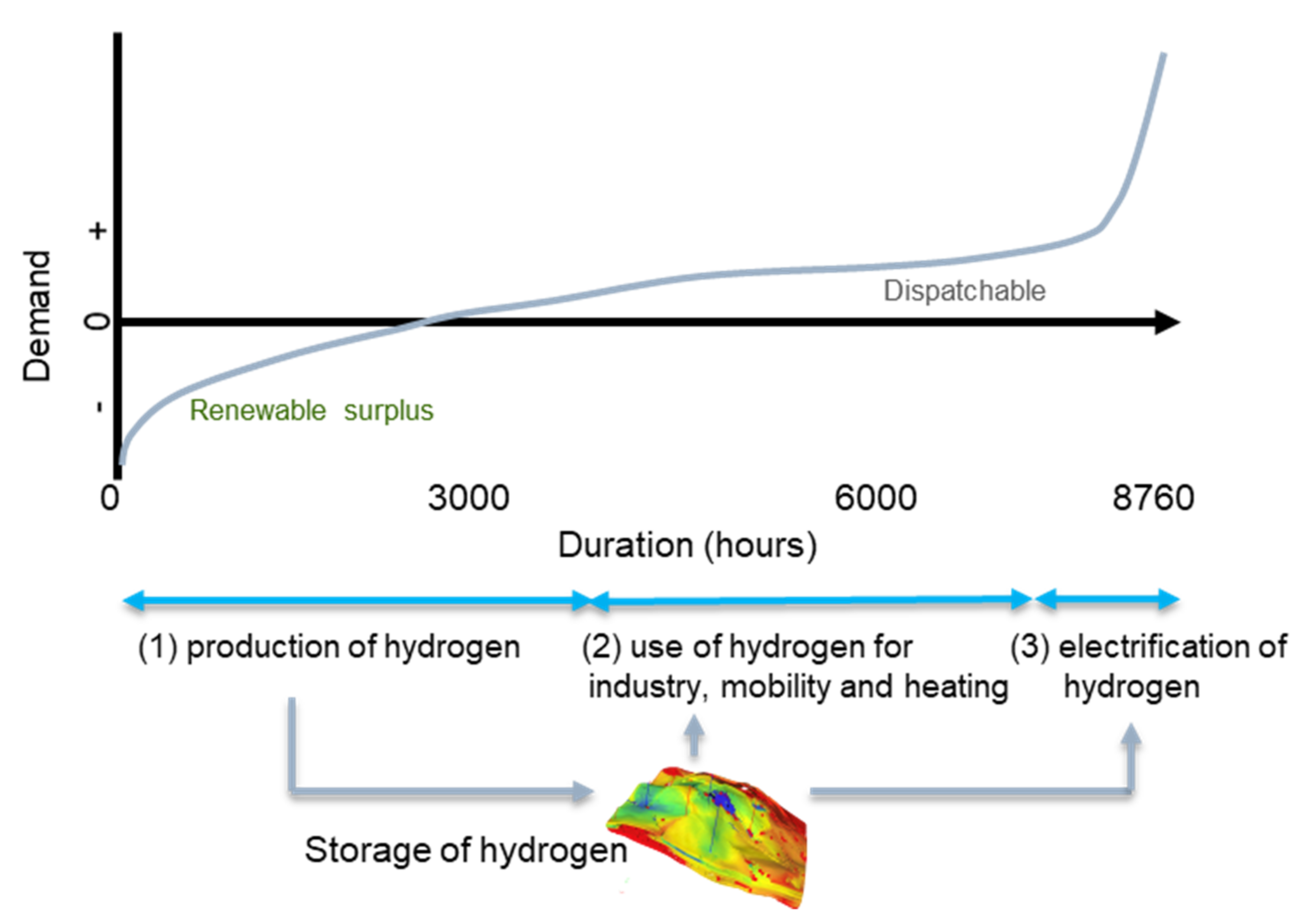
References
- European Union. Establishing the Framework for Achieving Climate Neutrality and Amending Regulations (EC) No 401/2009 and (EU) 2018/1999 (‘European Climate Law’). Regulation (EU) 2021/1119 of the European Parliament and of the Council; European Commission: Brussels, Belgium, 2021. [Google Scholar]
- IPCC. Climate Change 2021: The Physical Science Basis. Contribution of Working Group I to the Sixth Assessment Report of the Intergovernmental Panel on Climate Change; IPCC: Geneva, Switzerland, 2021. [Google Scholar]
- European Commission. Council Directive EU 2018/2001: Promotion of Energy from Renewable Sources; European Commission: Brussels, Belgium, 2021. [Google Scholar]
- European Commission. The European Green Deal. Communication from the Commission to the European Parliament, the Council, the European Economic and Social Committee and the Committee of the Regions; European Commission: Brussels, Belgium, 2019. [Google Scholar]
- European Commission. A Hydrogen Strategy for a Climate-Neutral Europe. Communication from the Commission to the European Parliament, the Council, the European Economic and Social Committee and the Committee of the Regions; European Commission: Brussels, Belgium, 2020. [Google Scholar]
- IEA. Renewables 2021—Analysis and Forecast to 2026; IEA Report; IEA: Paris, France, 2021. [Google Scholar]
- IEA. Net Zero by 2050—A Roadmap for the Global Energy Sector; IEA Report; IEA: Paris, France, 2021. [Google Scholar]
- Republik Österreich. Erneuerbaren-Ausbau-Gesetz; Gesetz Republik Österreich: Vienna, Austria, 2021. [Google Scholar]
- European Commission. REPowerEU: Joint European Action for More Affordable, Secure and Sustainable Energy; Document 52022DC0108; European Commission: Brussels, Belgium, 2022. [Google Scholar]
- Austrian Energy Agency. Strategische Handlungsoptionen für Eine Österreichische Gasversorgung ohne Importe aus Russland; Report for Bundesministerum für Klimaschutz, Umwelt, Energie; Austrian Energy Agency: Vienna, Austria, 2022. [Google Scholar]
- Mauch, B.; Apt, J.; Carvalho, P.M.S.; Paulina, J. What day-ahead reserves are needed in electric grids with high levels of wind power? Environ. Res. Lett. 2013, 8, 034013. [Google Scholar] [CrossRef] [Green Version]
- Impram, S.; Nese, S.V.; Oral, B. Challenges of renewable energy penetration on power system flexibility: A survey. Energy Strategy Rev. 2020, 31, 100539. [Google Scholar] [CrossRef]
- Holttinenen, H.; Tuohy, A.; Milligan, M.; Silva, V.; Müller, S.; Söder, L. The Flexibility Workout: Managing Variable Resources and Assessing the Need for Power System Modification. IEEE Power Energy Mag. 2013, 11, 53–62. [Google Scholar] [CrossRef]
- Hillberg, E.; Zegers, A.; Herndler, B.; Wong, S.; Pompee, J.; Bourmaud, J.-Y.; Lehnhoff, S.; Migliavacca, G.; Uhlen, K.; Oleinikova, I.; et al. Power Transmission & Distribution Systems—Flexibility needs in the future power system. Discussion Paper. 2019. Available online: iea-isgan.org (accessed on 15 March 2022).
- Rüdisüli, M.; Teske, S.L.; Elber, U. Impact of an Increased Substitution of Fossil Energy Carriers with Electricity-Based Technologies on the Swiss Electricity System. Energies 2019, 12, 2399. [Google Scholar] [CrossRef] [Green Version]
- Argyrou, M.C.; Christodoulides, P.L.; Marouchos, C.C.; Kalogirou, S.A.; Florides, G.A.; Lazari, L. Overview of Energy Storage Technolgoeis and a Short-term Storage Applications for Wind Turbines. In Proceedings of the Twinty-Sixth International Ocan and Polar Engineering Conference, Rhodes, Greece, 26 June–1 July 2016. [Google Scholar]
- Dowling, J.A.; Rinaldi, K.Z.; Ruggles, T.H.; Davis, S.J.; Yuan, M.; Tong, F.; Lewis, N.S.; Caldeira, K. Role of Long-Duration Energy Storage in Variable Renewable Electricity Systems. Joule 2020, 4, 1907–1928. [Google Scholar] [CrossRef]
- IEA. Technology Roadmap—Hydrogen and Fuel Cells; IEA Report; IEA: Paris, France, 2015. [Google Scholar]
- Olabi, A.G.; Saleh Bahri, A.; Abdelghafar, A.A.; Baroutaji, A.; Sayed, E.T.; Alamim, A.H.; Rezk, H.; Abdelkareem, M.A. Large-vscale hydrogen production and storage technologies: Current status and future directions. Int. J. Hydrogen Energy 2021, 46, 23498–23528. [Google Scholar] [CrossRef]
- Zivar, D.; Kumar, S.; Foroozesh, J. Underground hydrogen storage: A comprehensive review. Int. J. Hydrogen Energy 2021, 46, 23436–23462. [Google Scholar] [CrossRef]
- Kruck, O.; Crotogino, F.; Prelicz, R.; Rudolph, T. Overview on All Known Underground Storage Technologies for Hydrogen. Report. HyUnder Grant Agreement No.: 303417 Deliverable No. 3.1. 2013. Available online: http://hyunder.eu/wp-content/uploads/2016/01/D3.1_Overview-of-all-known-underground-storage-technologies.pdf (accessed on 20 March 2020).
- Londe, L.F. Four Ways to Store Large Quantities of Hydrogen. In Proceedings of the Abu Dhabi International Petroleum Exhibition & Conference, Abu Dhabi, United Arab Emirates, 15–18 November 2021. SPE-208178. [Google Scholar]
- Ogden, J.M. Prospects for Building a Hydrogen Energy Infrastructure. Annu. Rev. Energy Environ. 1999, 24, 227–279. [Google Scholar] [CrossRef]
- Scafidi, J.; Wilkinson, M.; Gilfillan, S.M.V.; Heinemann, N.; Haszeldine, R.S. A quantitative assessment of the hydrogen storage capacity of the UK continental shelf. Int. J. Hydrogen Energy 2021, 46, 8629–8639. [Google Scholar] [CrossRef]
- Henkel, S.; Pudlo, D.; Werner, L.; Enzman, F.; Reitenbach, V.; Albrecht, D.; Würdeman, H.; Heister, K.; Gsnzer, L.; Gaupp, R. Mineral reactions in the geological underground induced by H2 and CO2 injections. Energy Procedia 2014, 63, 8026–8035. [Google Scholar] [CrossRef] [Green Version]
- Mahdi, D.S.; Al-Khadheeawi, E.A.; Yuan, Y.; Zhang, Y.; Iglauer, S. Hydrogen underground storage efficiency in a heterogeneous sandstone reservoir. Adv. Geo-Energy 2021, 5, 437–443. [Google Scholar] [CrossRef]
- Heinemann, N.; Alcalde, J.; Miocic, J.M.; Hangx, S.J.T.; Kallmeyer, J.; Ostertag-Hennning, C.; Hassanpouryouzband, A.; Thaysen, E.M.; Strobel, G.J.; Schmidt-Hattenberger, C.; et al. Enabling large-scale hydrogen storage in porous media—The scientific challenges. Energy Environ. Sci. 2021, 14, 853–864. [Google Scholar] [CrossRef]
- EIW. Wasserstoff Zentraler Baustein der Energiewende; EIWInsights, Wasserstoff; Energieinstitut der Wirtschaft EIW: Vienna, Austria, 2021. [Google Scholar]
- Lechinger, V.; Matzinger, S. So Heizt Österreich—Heizungsarten und Energieträger in österreichischen Haushalten im Sozialen Kontext. Report. AK Wirtschaftspolitik Standpunke 1. 2020. Available online: https://energytransition.klimafonds.gv.at/wp-content/uploads/sites/7/2020/05/So-heizt-%C3%96sterreich.pdf (accessed on 25 February 2022).
- ÖVGW. Gasbeschaffenheit. Richtlinie G B 210. Regulation. Regel der Österreichische Vereinigung für das Gas- und Wasserfach (ÖVGW). 2021. Available online: https://portal.ovgw.at/pls/f?p=101:203::::RP,203:P203_ID,P203_FROM_PAGE_ID:1075524,202 (accessed on 30 March 2022).
- Melaina, M.W.; Antonia, O.; Penev, M. Blending Hydrogen into Natural Gas Pipeline Networks: A Review of Key Issues; Technical Report NREL/TP-5600+51995; National Renewable Energy Laboratory: Golden, CO, USA, 2013. [Google Scholar]
- Cerniauskas, S.; Chavez Junco, A.J.; Grube, T.; Robinius, M.; Stolten, D. Options of natural gas pipeline reassignment for hydrogen: Cost assessment for a Germany case study. Int. J. Hydrogen Energy 2020, 45, 12095–12107. [Google Scholar] [CrossRef] [Green Version]
- VCÖ. Kurzbericht Entwicklung Kerosinverbrauch und CO2-Emissionen des Flugverkehrs in Österreich; Mobilität mit Zukunft. Bericht; VCÖ: Vienna, Austria, 2019. [Google Scholar]
- McKinsey. Hydrogen-Powered Aviation—A Fact-Based Study of Hydrogen Technology, Economics, and Climate Impact by 2020; Study for the Clean Sky 2 JU and Fuel Cells and Hydrogen 2 JU; McKinsey: Brussels, Belgium, 2020. [Google Scholar]
- Yusaf, T.; Fernandez, L.; Abu Talib, A.B.; Altarazi, Y.S.M.; Alrefae, W.; Kadirgama, K.; Ramasamy, D.; Jayasuriya, A.; Brown, G.; Mamat, R.; et al. Sustainable Aviation—Hydrogen Is the Future. Sustainability 2022, 14, 548. [Google Scholar] [CrossRef]
- Wang, A.; Jens, J.; Mavins, D.; Moultak, M.; Schimmel, M.; van der Leun, K.; Peters, D.; Buseman, M. Report: Analysing Future Demand, Supply, and Transport of Hydrogen. European Hydrogen Backbone. Report. June 2021. Available online: https://gasforclimate2050.eu/wp-content/uploads/2021/06/EHB_Analysing-the-future-demand-supply-and-transport-of-hydrogen_June-2021.pdf (accessed on 24 February 2022).
- Clemens, T.; Poeschko, M.; Lueftenegger, M. The Impact of the Advent of E-Cars on Transport Fuel Consumption. In Proceedings of the 22nd World Petroleum Congress, Istanbul, Turkey, 9–13 July 2017. [Google Scholar]
- Ball, M.; Wietschel, M. The future of hydrogen–opportunities and challenges. Int. J. Hydrogen Energy 2009, 34, 615–627. [Google Scholar] [CrossRef]
- Statista. 2021. Available online: https://de.statista.com/statistik/daten/studie/962273/umfrage/treibhausgas-emissionen-des-sektors-verkehr-in-oesterreich-nach-verursacher/ (accessed on 14 February 2022).
- Anderl, M.; Geiger, K.; Gugele, B.; Gössl, M.; Haider, S.; Heller, C.; Köther, T.; Krutzler, T.; Kuchel, V.; Lampert, C.; et al. Report: REP-0738 Umweltbundesamt. Klimaschutzbericht 2020. 2020. Available online: https://www.umweltbundesamt.at/fileadmin/site/publikationen/rep0738.pdf (accessed on 3 March 2022).
- Ali, M.B.; Saidur, R.; Hossain, M.S. A review on emission analysis in cement industries. Renew. Sustain. Energy Rev. 2011, 15, 2252–2261. [Google Scholar] [CrossRef]
- Benhelal, E.; Zahedi, G.; Shamsaei, E.; Bahadori, A. Global strategies and potentials to curb CO2 emissions in cement industry. J. Clean. Prod. 2013, 51, 142–161. [Google Scholar] [CrossRef]
- Vogl, V.; Ahman, M.; Nilsson, L.J. Assessment of hydrogen direct reduction for fossil-free steelmaking. J. Clean. Prod. 2018, 203, 736–745. [Google Scholar] [CrossRef]
- Toktarova, A.; Göransson, L.; Johnsson, F. Design of Clean Steel Production with Hydrogen: Impact of Electricity System Composition. Energies 2021, 14, 8349. [Google Scholar] [CrossRef]
- Holmes, K.J.; Zeitler, E.; Kerxhalli-Kleinfeld, M.; DeBoer, R. Scaling Deep Decarbonization Technologies. Earth’s Future 2021, 9, e2021EF002399. [Google Scholar] [CrossRef]
- Bundesministerium Klimaschutz, Umwelt, Energie, Mobilität, Innovation und Technologie. 2020. Report: Energie in Österreich–Zahlen, Daten, Fakten. 2021. Available online: https://www.bmk.gv.at/dam/jcr:f0bdbaa4-59f2-4bde-9af9-e139f9568769/Energie_in_OE_2020_ua.pdf (accessed on 19 February 2022).
- Van Gerwen, R.; Eijgelaar, M.; Bosma, T. Hydrogen in the Electricity Value Chain. DVN GL Group Technology & Research. Position Paper. 2019. Available online: https://energeia-binary-external-prod.imgix.net/Ev5fBfgzH3mvL3FOErMDpw0D3Zg.pdf?dl=DNV+GL+-+Hydrogen+in+the+Electricity+Value+Chain.pdf (accessed on 14 February 2022).
- Vandewalle, J.; Bruninx, K.; D’haeseleer, W. Effects of large-scale power to gas conversion on the power, gas and carbon sectores and their interactions. Energy Convers. Manag. 2015, 94, 28–39. [Google Scholar] [CrossRef] [Green Version]
- Prasad, V.N. Hydrogen as a Path to Sector-Coupled Deep Decarbonization. In Proceedings of the Abu Dhabi International Petroleum Exhibition & Conference, Abu Dhabi, United Arab Emirates, 9–12 November 2020. Paper SPE-202999. [Google Scholar]
- Mendonca, C.; Ferreira, A.; Santos, D.M.F. Towards the Commercialization of Solid Oxide Fuel Cells: Recent Advances in Materials and Integration Strategies. Fuels 2021, 2, 393–419. [Google Scholar] [CrossRef]
- Sher, F.; Pans, M.A.; Sun, C.; Snape, C.; Liu, H. Oxy-fuel combustion study of biomass fuels in a 20 kWth fluidized bed combustor. Fuel 2018, 215, 778–786. [Google Scholar] [CrossRef]
- Kosowska-Golachowska, M.; Luckos, A.; Kijo-Kleczkowska, A. Pollutant Emissions during Oxy-Fuel Combustion of Biomass in a Bench Scale CFB Combustor. Energies 2022, 15, 706. [Google Scholar] [CrossRef]
- Hänggi, S.; Elbert, P.; Bütler, T.; Cabalzar, U.; Teske, S.; Bach, C.; Onder, C. A review of synthetic fuels for passenger vehicles. Energy Rep. 2019, 5, 555–569. [Google Scholar] [CrossRef]
- Siegemund, S.; Schmidt, P.; Trommler, M.; Weindorf, W.; Kolb, O.; Zittel, W.; Zinnercker, V.; Raksha, T.; Zerhusen, J. E-Fuels Study, the Potential of Electricity-Based Fuels for Low-Emission Transport in the EU; Deutsche Energie Agentur: Berlin, Germany, 2017. [Google Scholar]
- Thomson, R.; Weichenhain, U.; Sachdeva, M.; Gupta, A.; Stern, C.; Trueman, N. Hydrogen: A Future Fuel for Aviation? Focus Roland Berger: Munich, Germany, 2020. [Google Scholar]
- Mankins, J.C. Technology Readiness Levels—A White Paper; NASA: Washington, DC, USA, 1995. [Google Scholar]
- IEAGHG. Global Assessment of Direct Air Capture Costs; IEAGHG Technical Report 2021-05; IEAGHG: Cheltenham, UK, 2021. [Google Scholar]
- Bloomberg NEF. Hydrogen Economic Outlook; Report; Bloomberg Finance L.P.: New York, NY, USA, 2020. [Google Scholar]
- E-Control. 2021. Statistikbrochüre. 2021. Available online: https://www.e-control.at/documents/1785851/1811582/E-Control-Statbro-2021.pdf/83442b63-df8c-a732-7152-8df34986c2c3?t=1636364279845 (accessed on 5 March 2022).
- IEA. Austria 2020—Energy Policy Review; IEA Report; IEA: Paris, France, 2020. [Google Scholar]
- Biermayr, P. Erneuerbare Energie in Zahlen 2018—Entwicklung in Österreich Datenbasis 2017; Report, e-Think; Zentrum für Energiewirtschaft und Umwelt: Vienna, Austria, 2018. [Google Scholar]
- Pöyry. Österreichs E-Wirtschaft—Wasserkraftpotenzialstudie Österreich; Aktualisierung 2018. Bericht 2018; Pöyry Austria GmBH: Vienna, Austria, 2018. [Google Scholar]
- Moser, S.; Goers, S.; de Bruyn, K.; Steinmüller, H.; Hofmann, R.; Panuschka, S.; Kienberger, T.; Sejkora, C.; Haider, M.; Werner, A.; et al. Abstimmung des Energiebedarfs von Industriellen Anlagen und der Energieversorgung aus Fluktuierenden Erneuerbaren. Report for Project Renewables4Industry. 2018. Available online: https://energieinstitut-linz.at/wp-content/uploads/2018/04/Renewables4Industry-Diskussionspapier.pdf (accessed on 14 February 2022).
- Wolf, G. Klimaschutz in Österreich: Maßnahmen und Investitionsbedarf—Ein Überblick; Analysen; Bank Austria: Vienna, Austria, 2020. [Google Scholar]
- Königshofer, K.; Domberger, G.; Gunczy, S.; Hingsamer, M.; Pucker, J.; Schreilechner, M.; Amtmann, J.; Goldbrunner, J.; Heiss, H.P.; Füreder, J.; et al. Potenzial der Tiefengeothermie für die Fernwärme- und Stromproduktion in Österreich. 2014. Available online: https://energieforschung.at/wp-content/uploads/sites/11/2020/12/834451-Endbericht-GeoEnergie2050-30062014-final.pdf (accessed on 21 January 2022).
- IEA. IEA Bioenergy Countries’ Report; IEA Bioenergy Report. Project Number N41029016; IEA: Paris, France, 2016. [Google Scholar]
- Resch, G.; Burghozer, B.; Totschnig, G.; Lettner, G.; Auer, H.; Geipel, J. Stromzukunft Österreich 2030—Analyse der Erfordernisse und Konsequenzen eines Ambitionierten Ausbaus Erneuerbarer Energien. Endbericht. May 2017. Available online: https://www.igwindkraft.at/mmedia/download/2018.02.05/1517824995073289.pdf (accessed on 1 February 2022).
- SolarGIS. GeoModel Solar, CC BY-SA 3.0. Available online: https://commons.wikimedia.org/w/index.php?curid=33523153 (accessed on 5 March 2022).
- Fechner, H. Ermittlung des Flächenpotentials für den Photovoltaik-Ausbau in Österreich: Welche Flächenkategorien sind für die Erschließung von besonderer Bedeutung, um das Ökostromziel realisieren zu können. Sudie im Auftrag von Österreichs Energie, Endbericht. 2020. Available online: https://oesterreichsenergie.at/fileadmin/user_upload/Oesterreichs_Energie/Publikationsdatenbank/Studien/2020/PV-Studie_2020.pdf (accessed on 4 February 2022).
- Trommsdorff, M.; Gruber, S.; Keinath, T.; Kopf, M.; Hermann, C.; Schönberger, F.; Högy, P.; Zikeli, S.; Ehmann, A.; Weselek, A.; et al. Agrivoltaics: Opportunities for Agriculture and the Energy Transition; Fraunhofer Institute for Solar Energy Systems ISE: Breisgau, Germany, 2020. [Google Scholar]
- Abidin, M.A.Z.; Mahyuddin, M.N.; Zainuri, M.A.A.M. Solar Photovoltaic Architecture and Agronomic Agrivoltaic System: A Review. Sustainability 2021, 13, 7846. [Google Scholar] [CrossRef]
- Österreichischer Biomasse-Verband 2019. Basisdaten 2019—Bioenergie. Österreichischer Biomasse-Verband. 2019. Available online: https://www.biomasseverband.at/wp-content/uploads/Basisdaten_Bioenergie_2019.pdf (accessed on 11 February 2022).
- Scharf, J.; Grieb, M.; Fritz, M. Agri-Photovoltaik—Stand und offene Fragen. Technologie- und Förderzentrum im Kompetenzzentrum für Nachwachsende Rohstoffe. Berichte aus dem TF/73. 2021. Available online: https://www.tfz.bayern.de/mam/cms08/rohstoffpflanzen/dateien/tfz_bericht_73_agri-pv.pdf (accessed on 5 February 2022).
- WKO. Branchenreport Mineralöl. Fachverband Mineralölindustrie; WKO: Wien, Austria, 2020. [Google Scholar]
- Christian, R.; Feichtinger, R.; Christian, R.; Bolz, R.; Windsperger, A.; Hummel, M.; Weish, P.; Pfnier, E. Zukunftsfähige Energieversorgung für Österreich. Berichte aus Energie- und Umweltforschung 13/2011; Innovation und Technologie; Bundesministerium für Verkehr: Berlin, Germany, 2011. [Google Scholar]
- Kranzl, L.; Müller, A.; Maia, I.; Büchele, R. Wärmewende 2030: Analyse der Erfordernisse und Konsequenzen—Teilbericht zur Wirtschaftlichkeitsanalyse von Heizsystmen. Bericht EEÖ—Erneuerbare Energy Österreich. November 2017. Available online: https://www.propellets.at/assets/upload/Presseaussendungen/16.11.2017%20TU%20Studie%20Heizkostenvergleich/Studie_Waermewende_2030.pdf (accessed on 26 February 2022).
- Clemens, M.; Clemens, T.; Zechner, M. BEV, PHEV, ICE Vehicles and the Role of Hydrogen Storage and Carbon Capture and Storage for Decarbonisation of Private Transport. In Proceedings of the ECEEE Summer Study Proceedings 2021, Virtual, 7–11 June 2021. Paper 6-017-21_Clemens. [Google Scholar]
- IEA. Global EV Outlook 2021; Report International Energy Agency; IEA: Paris, France, 2021. [Google Scholar]
- Cunanan, C.; Tran, M.-K.; Lee, Y.; Kwok, S.; Leung, V.; Fowler, M. A Review of Heavy-Duty Vehicle Powertrain Technologies: Diesel Engine Vehicles, Battery Electric Vehicles, and Hydrogen Fuel Cell Vehicles. Clean Technol. 2021, 3, 474–489. [Google Scholar] [CrossRef]
- Ablatayneh, A.; Assaf, M.N.; Alterman, D.; Jaradat, M. Comparison of the Overall Efficiency for Internal Combustion Engine Vehicles and Electric Vehicles. Environ. Clim. Technol. 2020, 24, 669–680. [Google Scholar]
- IEA. The Future of Hydrogen; International Energy Agency Report; IEA: Paris, France, 2019. [Google Scholar]
- Hao, X.; Wang, H.; Lin, Z.; Ouyang, M. Seasonal effects on electric vehicle energy consumption and driving range: A case study on personal, taxi, and ridesharing vehicles. J. Clean. Prod. 2020, 249, 119403. [Google Scholar] [CrossRef]
- Hydrogen Council. Hydrogen Insights—A Perspective on Hydrogen Investment, Market Development and Cost Competitiveness; Report; McKinsey & Company: Brussels, Belgium, 2021. [Google Scholar]
- Van Wijk, A. Hydrogen—A Carbon-Free Energy Carrier and Commodity; Hydrogen Europe: Bruxelles, Belgium, 2021. [Google Scholar]
- Navon, A.; Yosef, G.B.; Machlev, R.; Shapira, S.; Chowdhury, N.R.; Blikov, J.; Orda, A.; Levron, Y. Applications of Game Theory to Design and Operation of Modern Power Systems: A Comprehensive Review. Energies 2020, 13, 3982. [Google Scholar] [CrossRef]
- Ennis-King, J.; Michael, K.; Strand, J.; Sander, R.; Green, C. Underground Storage of Hydrogen: Mapping Out Options for Australia; Project Number: RP1-1.04, Deliverable 5: Final Summary Report; Future Fuels CRC: Vienna, Austria, 2021. [Google Scholar]
- Lipiarski, P. Erdöl- Erdgasdaten 2020—Österreich und weltweit. Zusammenfassung des GBA Erdölreferats 2020. 2021. Available online: https://opac.geologie.ac.at/ais312/dokumente/erdoelref_2020.pdf (accessed on 18 February 2022).
- Jens, J.; Wang, A.; van der Leun, K.; Peters, D.; Buseman, M. Extending the European Hydrogen Backbone—A European Hydrogen Infrastructure Vision Covering 21 Countries; Guidehouse: Utrecht, The Netherlands, 2021. [Google Scholar]
- Potter, I. Feasibility of hydrogen as an energy source. In Proceedings of the 20th World Petroleum Congress, Doha, Qatar, 4–8 December 2011. [Google Scholar]
- Franchi, G.; Capocelli, M.; de Falco, M.; Piemonte, V.; Barba, D. Hydrogen Production via Steam Reforming: A Critical Analysis of MR and RMM Technologies. Membrane 2020, 10, 10. [Google Scholar] [CrossRef] [PubMed] [Green Version]
- Noussan, M.; Raimondi, P.P.; Scita, R.; Hafner, M. The Role of Green and Blue Hydrogen in the Energy Transition—A Technological and Geopolitical Perspective. Sustainability 2021, 13, 298. [Google Scholar] [CrossRef]
- WEC. Hydrogen Demand and Cost Dynamics; World Energy Council Working Paper; WEC: London, UK, 2021. [Google Scholar]
- Soltani, R.; Rosen, M.A.; Dincer, I. Assessment of CO2 capture options from various points in steam methane reforming for hydrogen production. Int. J. Hydrogen Energy 2014, 39, 20266–20275. [Google Scholar] [CrossRef]
- Ehlig-Economides, C.; Hatzignatiou, D.G. Blue Hydrogen Economy—A New Look at an Old Idea. In Proceedings of the SPE Annual Technical Conference and Exhibition, Dubai, United Arab Emirates, 21–23 September 2021. Paper SPE 206282. [Google Scholar]
- Lau, H.C. The Role of Fossil Fuels in a Hydrogen Economy. In Proceedings of the International Petroleum Technology Conference, Virtual, 16 March 2021. Paper IPTC-21162. [Google Scholar]
- Liu, R.E.; Ravikumar, A.P.; Bi, X.T.; Zhang, S.; Nie, Y.; Brand, A.; Bergerson, J.A. Greenhouse Gas Emissions of Western Canadian Natural Gas: Proposed Emissions Tracking for Life Cycle Monitoring. Environ. Sci. Technol. 2021, 55, 9711–9720. [Google Scholar] [CrossRef] [PubMed]
- Sanchez-Bastardo, N.; Schlögl, R.; Ruland, H. Methane Pyrolysis for Zero-Emission Hydrogen Production: A Potential Bridge Technology from Fossil Fuels to a Renewable and Sustainable Hydrogen Economy. Ind. Eng. Chem. Res. 2021, 60, 11855–11881. [Google Scholar] [CrossRef]
- Msheik, M.; Rodat, S.; Abanades, S. Methane Cracking for Hydrogen Production: A Review of Catalytic and Molten Media Pyrolysis. Energies 2021, 14, 3107. [Google Scholar] [CrossRef]
- Howarth, R.W.; Jacobson, M.Z. How green is blue hydrogen? Energy Sci. Eng. 2021, 9, 1676–1687. [Google Scholar] [CrossRef]
- Republik Österreich. Verbot der geologischen Speicherung von Kohlenstoffdioxid sowie Änderung des Umweltverträglichkeitsprüfungsgesetzes 2000, des Bundes-Umwelthaftungsgesetzes, der Gewerbeordnung 1994 sowie des Mineralrohstoffgesetzes. Bundesgesetzblatt für die Republik Österreich. Ausgegeben am 28. Dezember 2011. Available online: https://www.ris.bka.gv.at/Dokumente/BgblAuth/BGBLA_2011_I_144/BGBLA_2011_I_144.pdfsig (accessed on 6 January 2022).
- El-Emam, R.S.; Özcan, H. Comprehensive review on the techno-economics of sustainable large-scale clean hydrogen production. J. Clean. Prod. 2019, 220, 593–609. [Google Scholar] [CrossRef]
- Republik Österreich. Bundesverfassungsgesetz für ein Atomfreies Österreich; Gesetz Republik Österreich: Vienna, Austria, 1999. [Google Scholar]
- Buttler, A.; Spliethoff, H. Current status of water electrolysis for energy storage, grid balancing and sector coupling via power-to-gas and power-to-liquids: A review. Renew. Sustain. Energy Rev. 2018, 82, 2440–2454. [Google Scholar] [CrossRef]
- L’Huby, T.; Gahlot, P.; Debarre, R. Hydrogen Applications and Business Models—Going Blue and Green? Kearney Energy Transition Institute: Chicago, IL, USA, 2020. [Google Scholar]
- Ingersoll, E.; Gogan, K. Missing Link to a Livable Climate: How Hydrogen-Enabled Synthetic Fuels Can Help Deliver the Paris Goals; Lucid Catalyst: London, UK, 2020. [Google Scholar]
- Goldman Sachs. Green Hydrogen—The Next Transformational Driver of the Utilities; Equity Research; Goldman Sachs: New York, NY, USA, 2020. [Google Scholar]
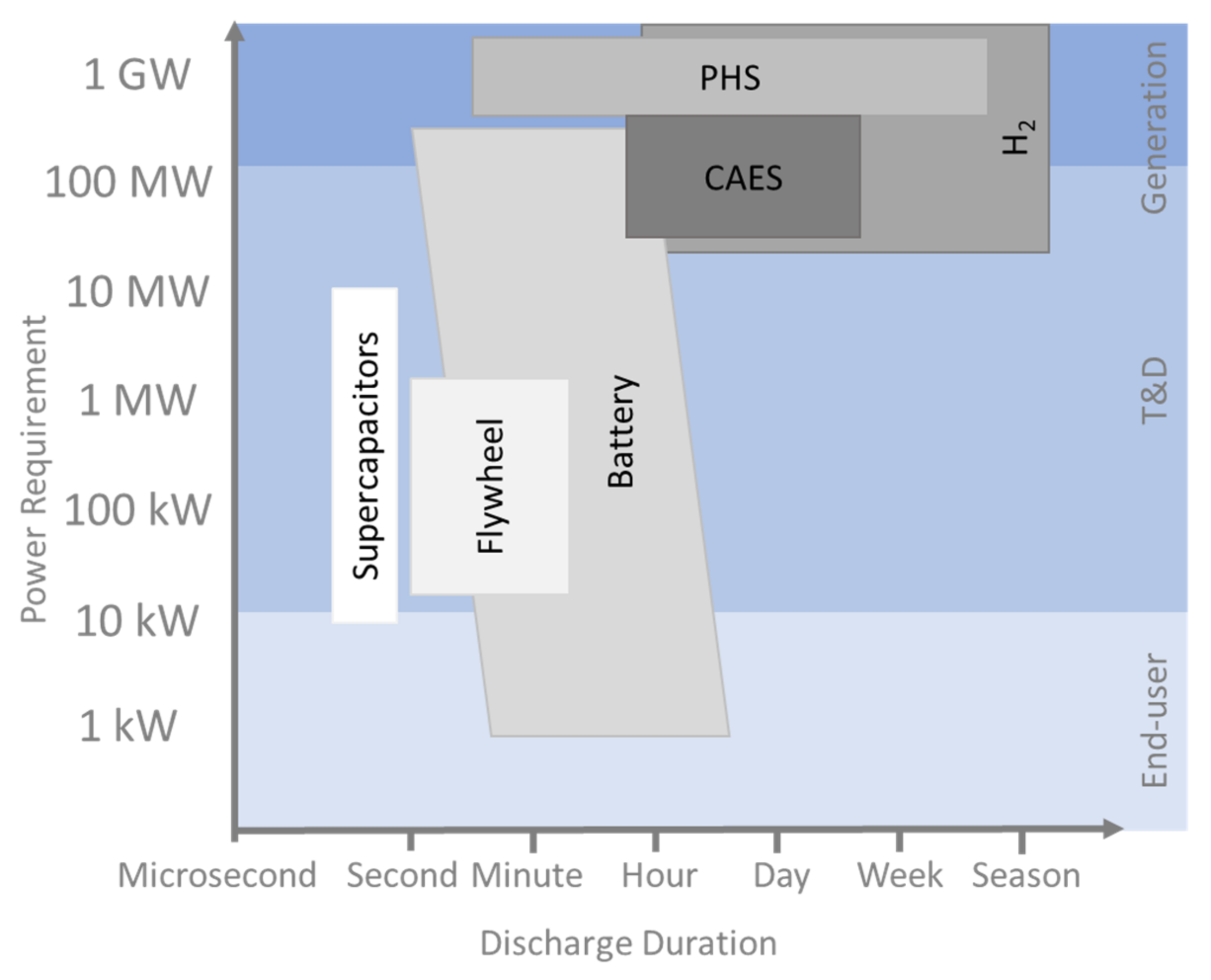
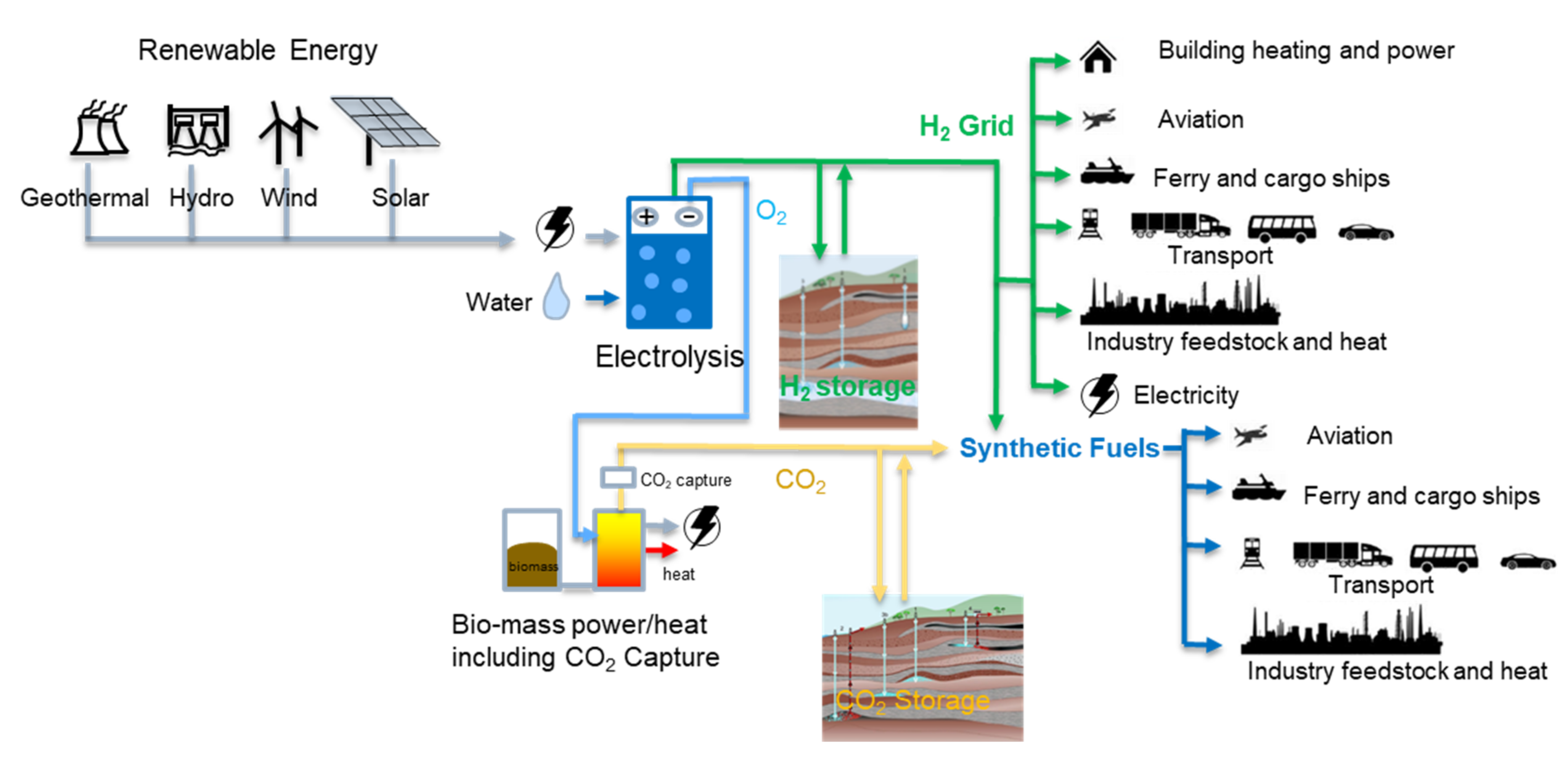
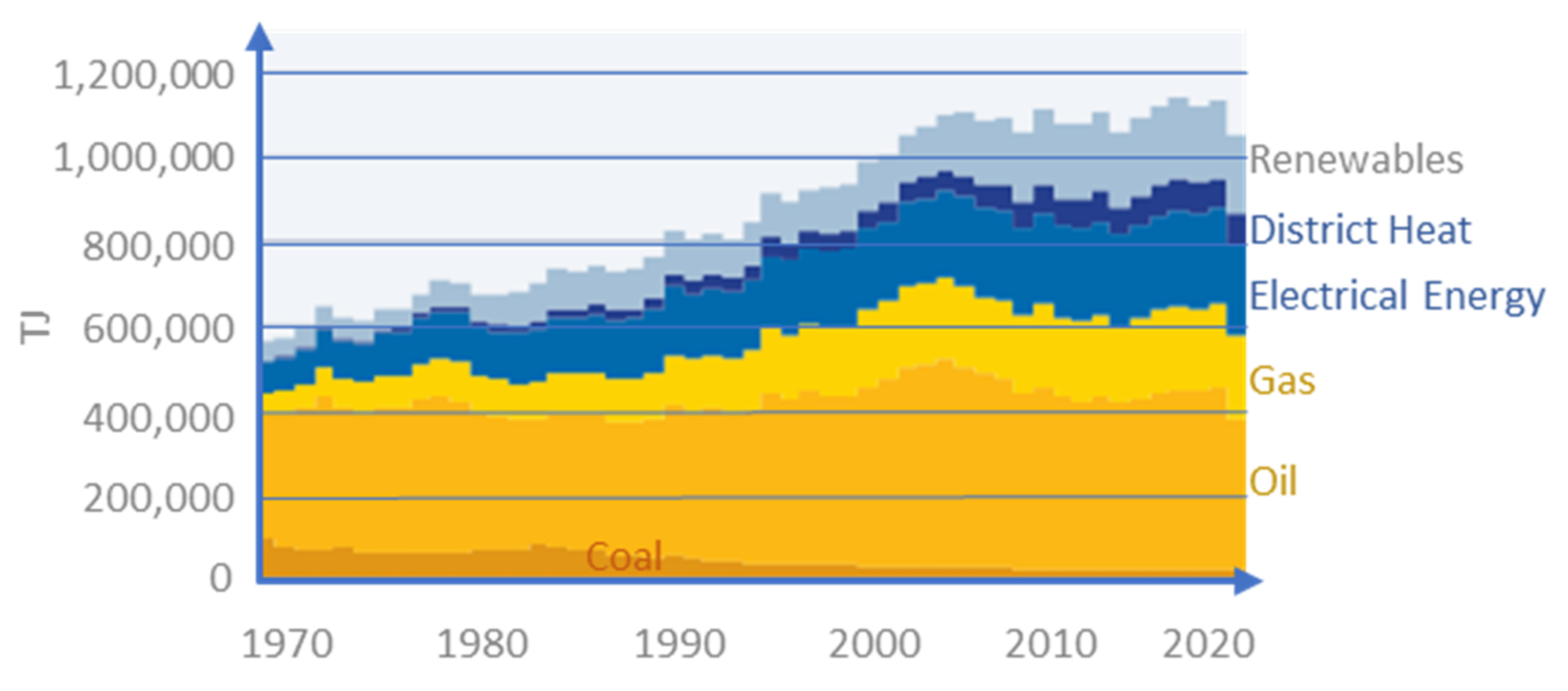

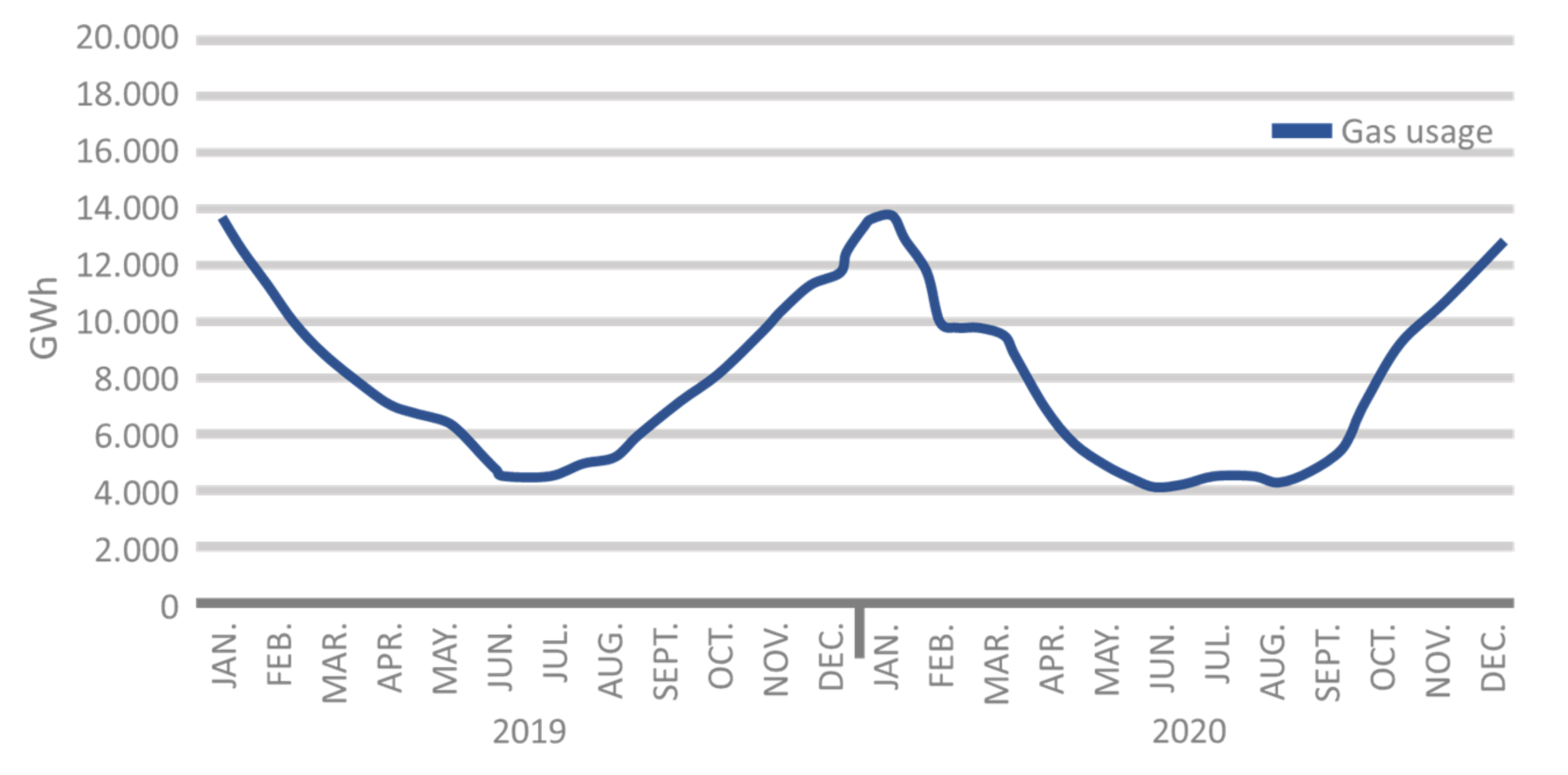


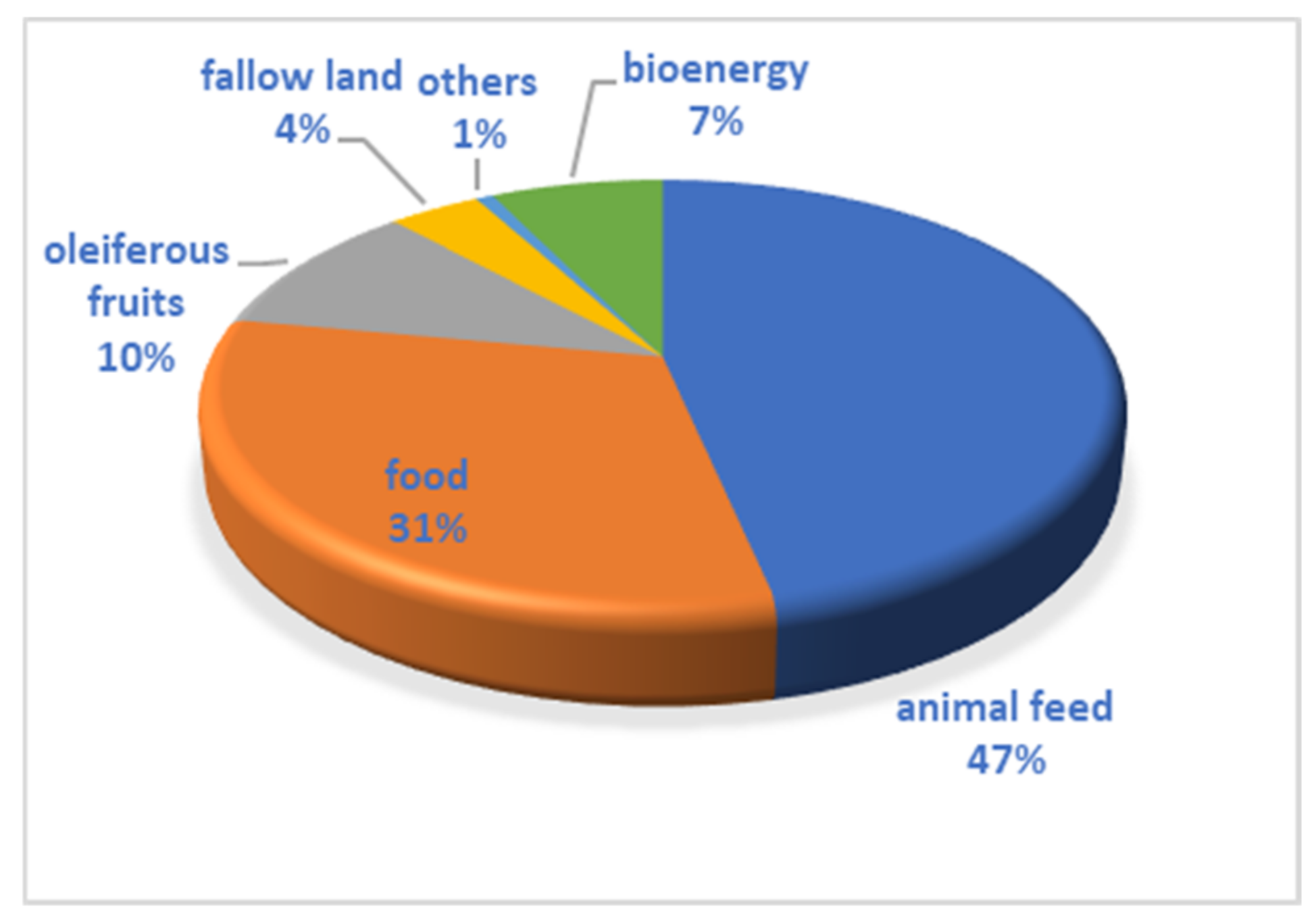
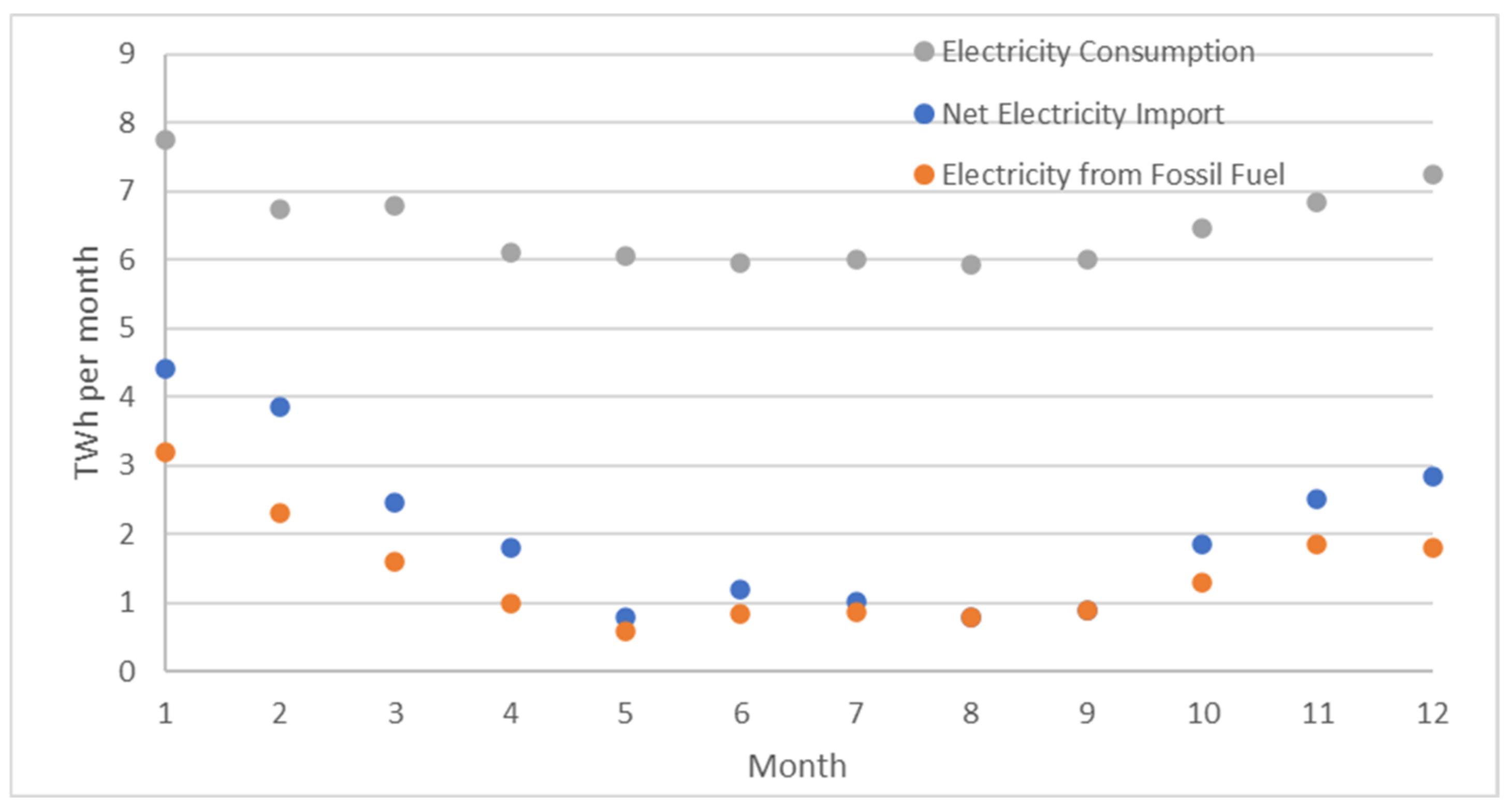

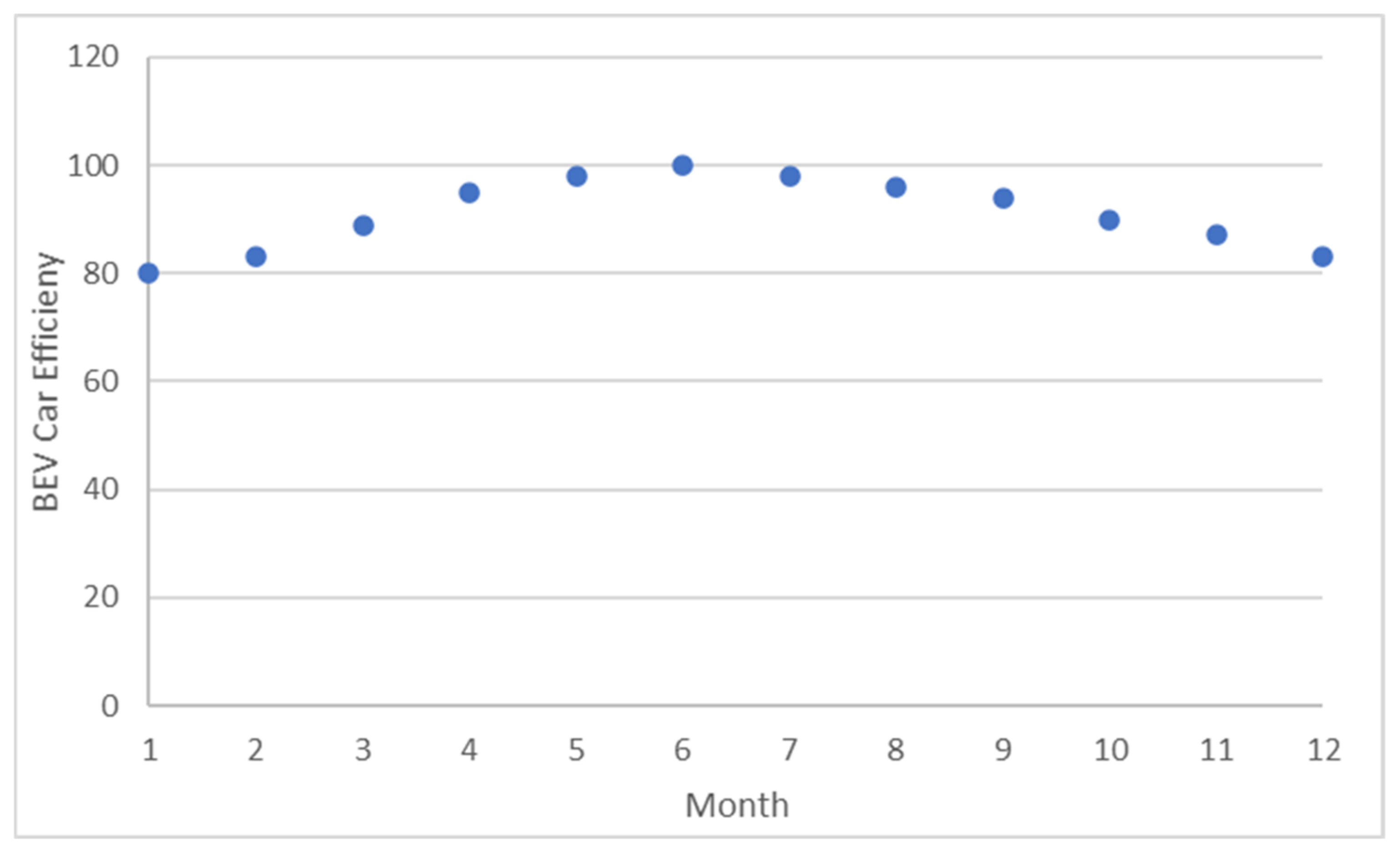
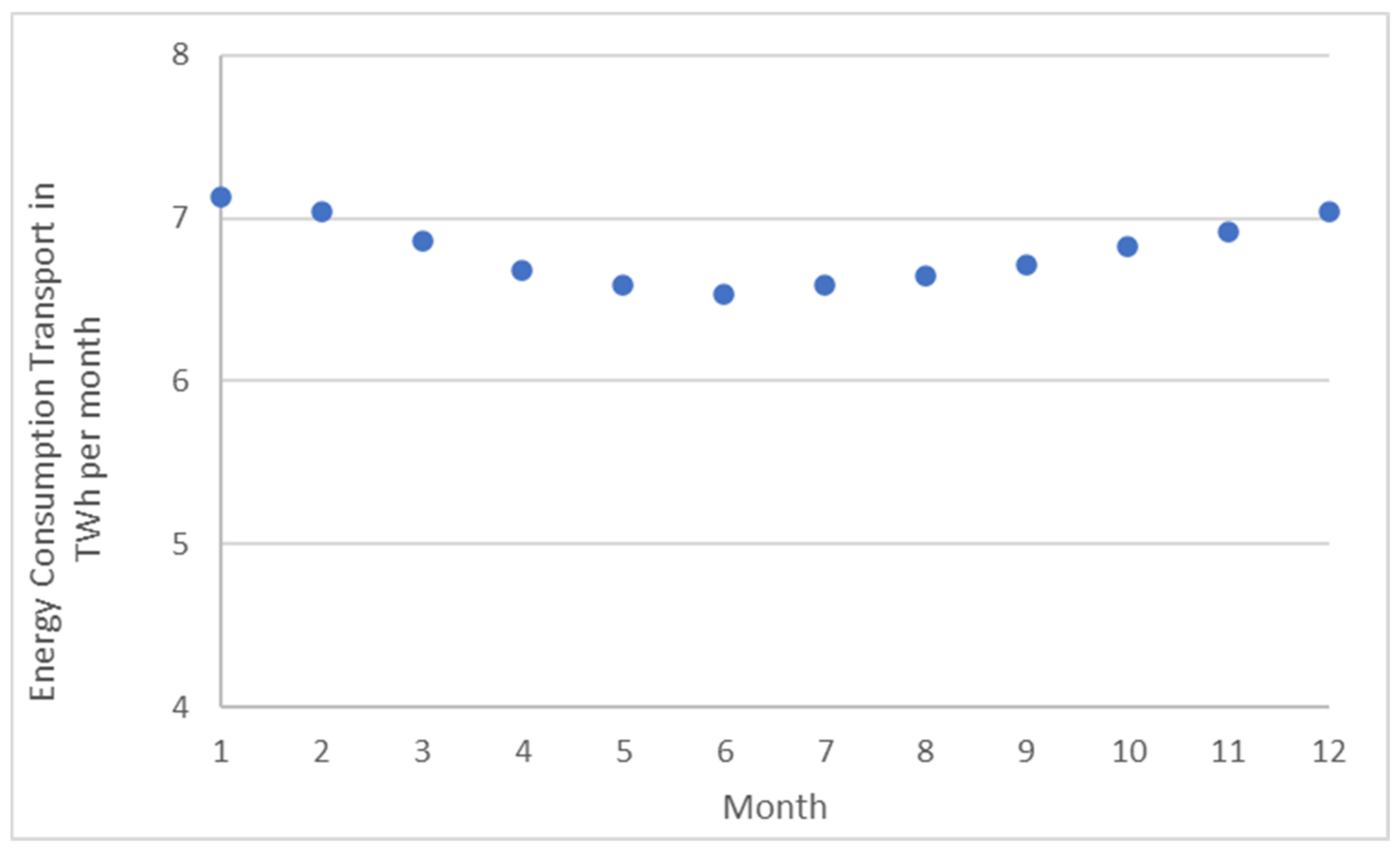
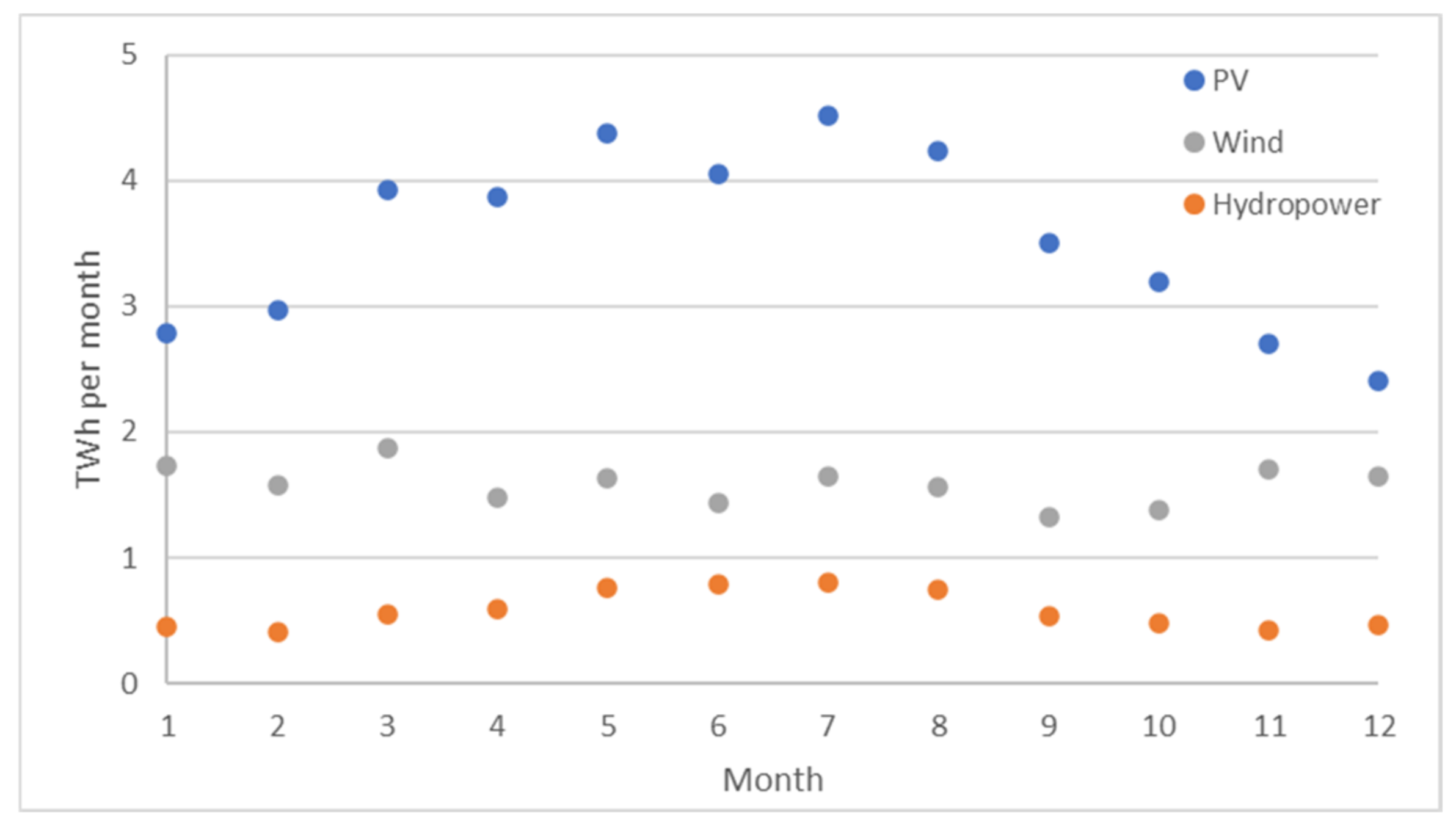
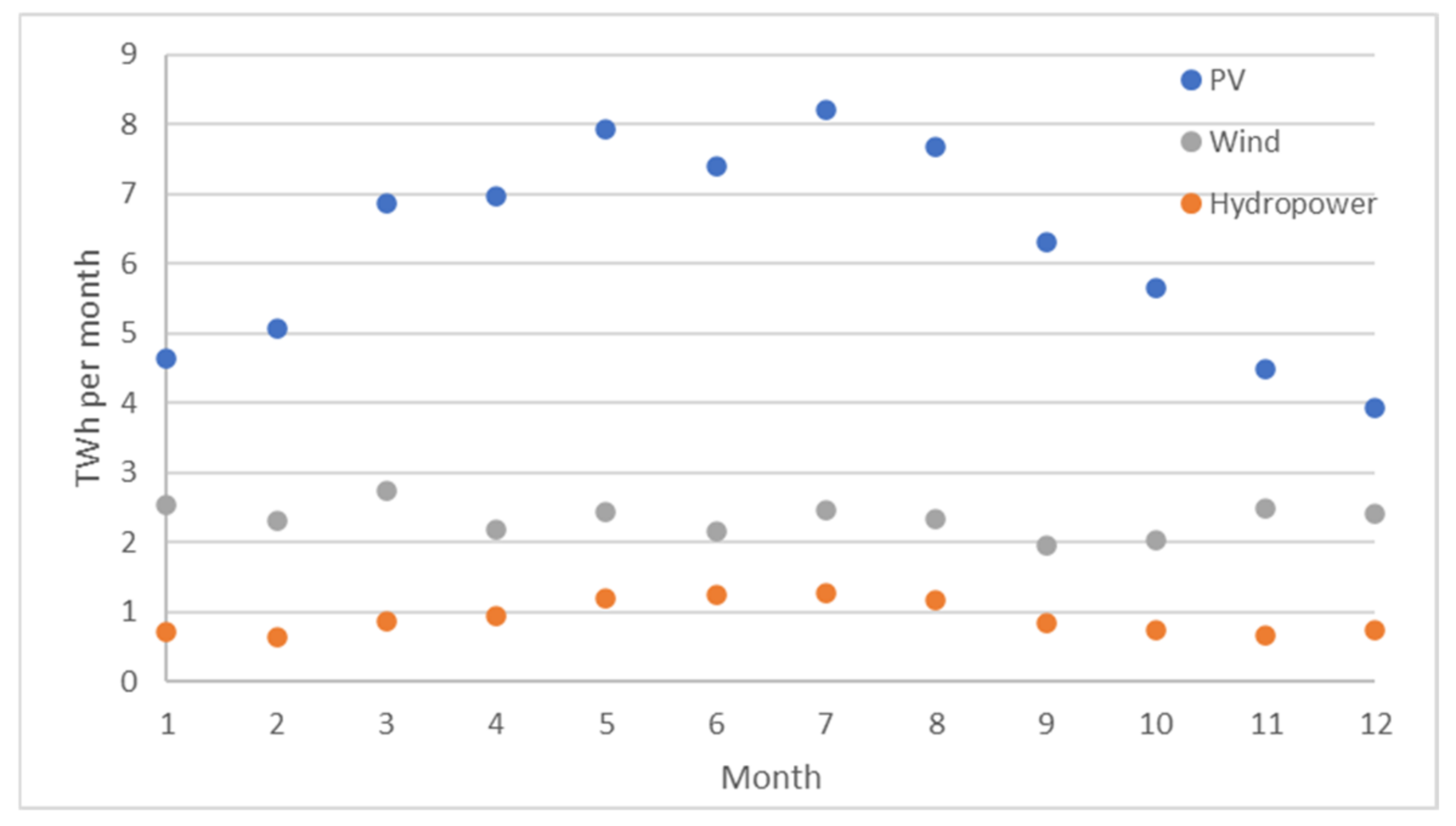
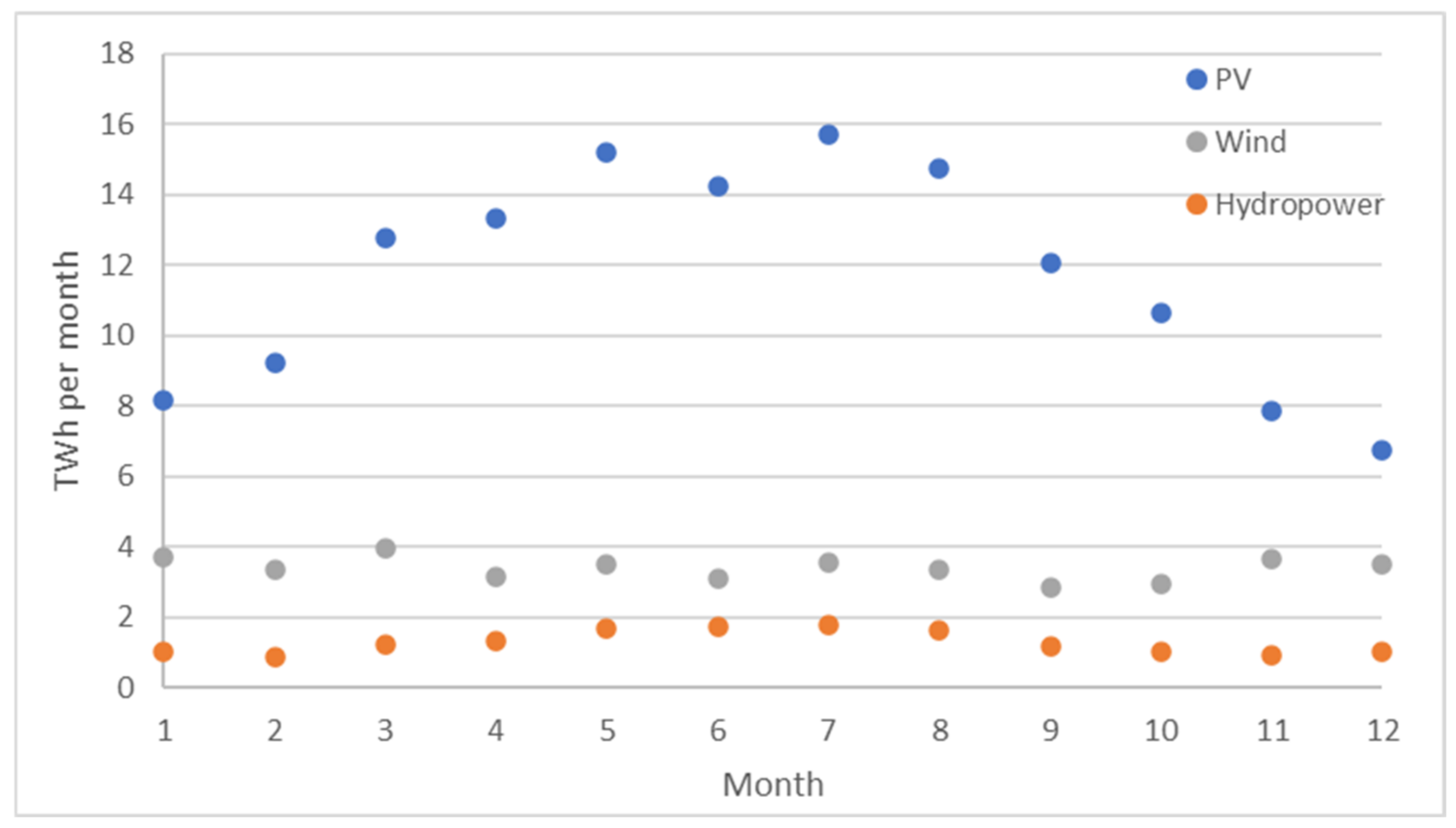
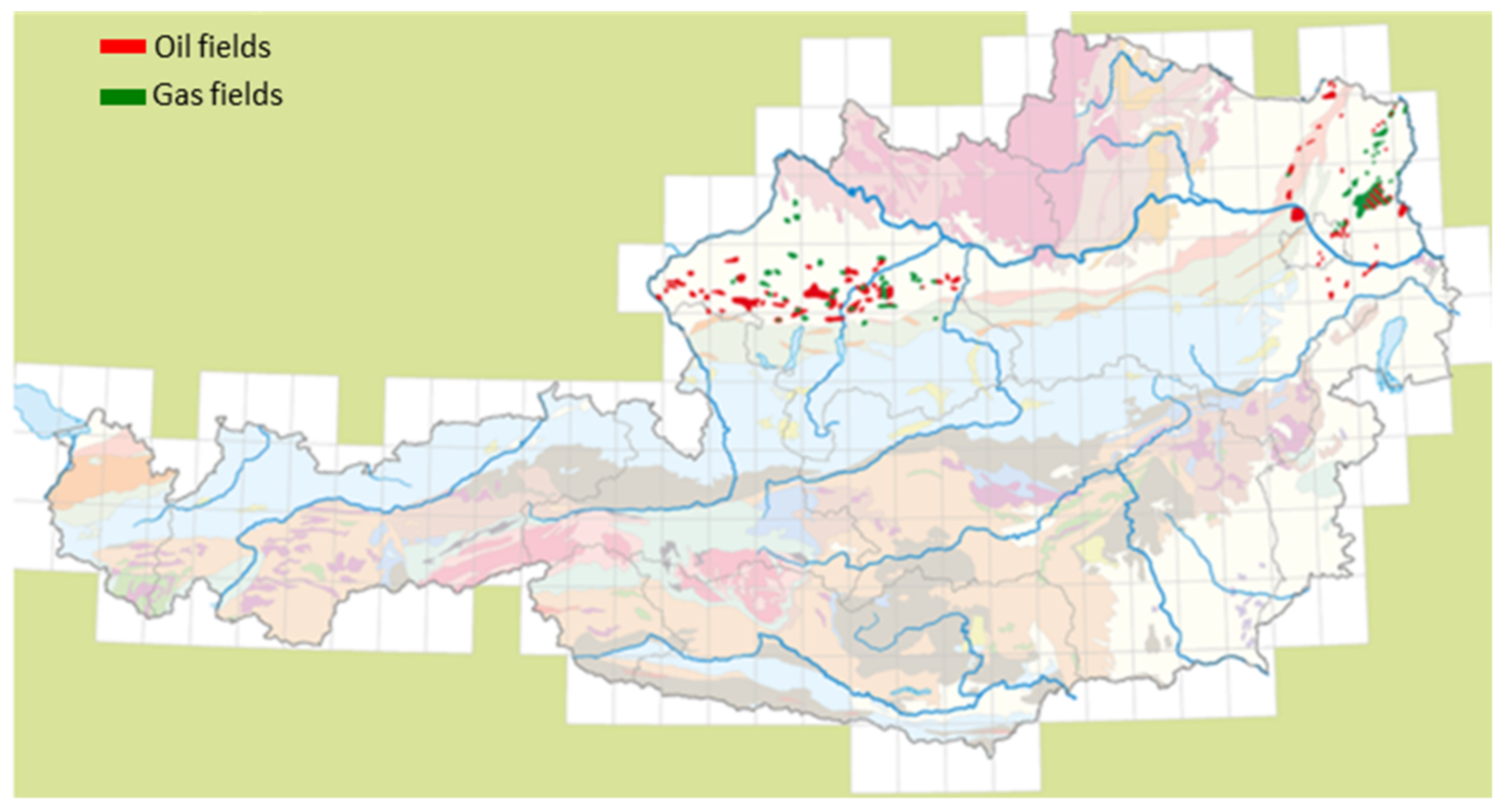

| Technical Potential in TWh | |
|---|---|
| Buildings | 13.4 |
| Land Fills | 1.2 |
| Along Roads and Railway Tracks | 4.5 |
| Open Space | 28–32 |
| January | Feb. | March | April | May | June | July | August | Sept. | Oct. | Nov. | Dec | |
|---|---|---|---|---|---|---|---|---|---|---|---|---|
| % | 16.1 | 13 | 12.5 | 8.1 | 3.5 | 2.2 | 1.7 | 1.6 | 6.2 | 8.4 | 11.2 | 15.5 |
| January | Feb. | March | April | May | June | July | August | Sept. | Oct. | Nov. | Dec | |
|---|---|---|---|---|---|---|---|---|---|---|---|---|
| Hydropower | 6.51 | 5.81 | 7.83 | 8.51 | 10.86 | 11.22 | 11.5 | 10.66 | 7.6 | 6.78 | 6.09 | 6.63 |
| Wind | 10.64 | 9.77 | 10.98 | 7.38 | 7.25 | 5.41 | 7.05 | 6.78 | 6.63 | 7.57 | 10.69 | 9.85 |
| PV | 4.47 | 5.88 | 8.77 | 10.15 | 11.68 | 11.13 | 12.17 | 11.38 | 9.24 | 7.67 | 4.24 | 3.22 |
Publisher’s Note: MDPI stays neutral with regard to jurisdictional claims in published maps and institutional affiliations. |
© 2022 by the authors. Licensee MDPI, Basel, Switzerland. This article is an open access article distributed under the terms and conditions of the Creative Commons Attribution (CC BY) license (https://creativecommons.org/licenses/by/4.0/).
Share and Cite
Clemens, M.; Clemens, T. Scenarios to Decarbonize Austria’s Energy Consumption and the Role of Underground Hydrogen Storage. Energies 2022, 15, 3742. https://doi.org/10.3390/en15103742
Clemens M, Clemens T. Scenarios to Decarbonize Austria’s Energy Consumption and the Role of Underground Hydrogen Storage. Energies. 2022; 15(10):3742. https://doi.org/10.3390/en15103742
Chicago/Turabian StyleClemens, Marcel, and Torsten Clemens. 2022. "Scenarios to Decarbonize Austria’s Energy Consumption and the Role of Underground Hydrogen Storage" Energies 15, no. 10: 3742. https://doi.org/10.3390/en15103742





